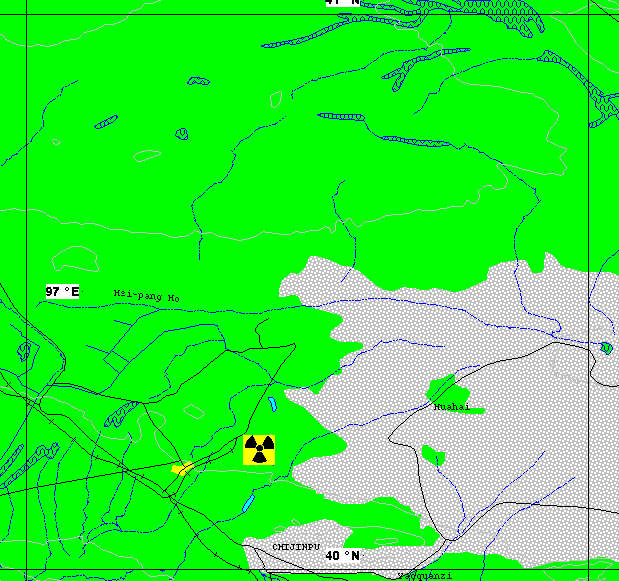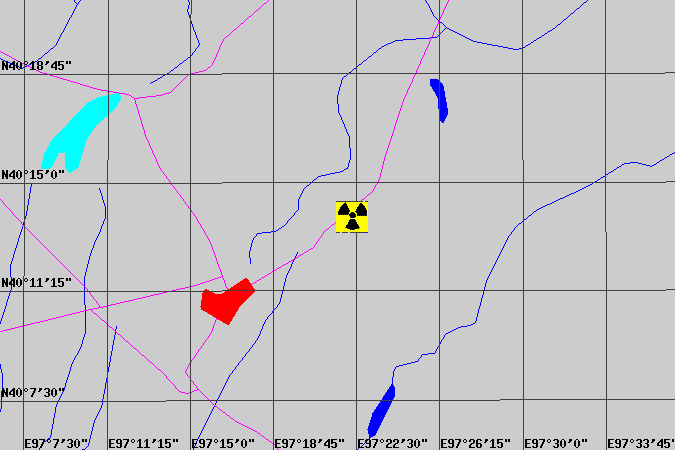



Jiuquan
404 Plant
Jiuquan Atomic Energy Complex
40�15'N 97�21'E
The Jiuquan Atomic Energy Complex (Plant 404) is centered on a 400-500MW light water graphite reactor [LWGR[ fueled with natural Uranium. The facility includes a pilot plutonium reprocessing plant and a large-scale reprocessing plant with a capacity of 300-400kg Pu/yr (both use PUREX method). It also includes a Nuclear Fuel Processing Plant for refining plutonium into weapons-usable metals.
Construction of a plutonium production complex at Jiuquan [Yumen, not at 39�36'N 94�58'E as otherwise reported], in Kansu Province, was started in 1958 or 1959. A suspected graphite-moderated water-cooled reactor at this location was first photographed by American intelligence satellites in 1962 and again in February 1964. At the latter date the reactor apparently was not operational, though it may have been shut down for change of fuel elements and hence it was possible, though by no means certain in the eyes of US intelligence, that the reactor might have been operational in 1962. Construction continued steadily for at least the next decade and operation of the large plutonium chemical separations plant position of the complex commenced in the latter part of 1970.
In the late 1960s as part of the "third line" effort to relocate critical defense infrastructure in the relatively remote interior, China built new [allegedly underground] facilities supplement the plutonium production reactor at
Jiuquan
[third line plutonium production reactor at Guangyuan
], the design and fabrication facility at Haiyan
[third line design and fabrication facility at Mianyang
], and the gaseous diffusion plant at Lanzhou
[third line plutonium processing facility at Yibin
]. In addition to the original plutonium production reactor at Jiuquan, the Chinese built a second very similar plutonium reactor and chemical separation plant at Guangyuan [Kuangyuan]. This facility began production in mid-1973, with approximately the same plutonium production capacity as the Jiuquan reactor of 300-400 Kg per annum.
The SverdNIIKhimmash research institute in Yekaterinburg entered into a contract with China, May 1995, to supply equipment for an oxalate plutonium refinement unit to be based at a military enterprise in the Gansu Province, which is shifting to civil-oriented production. China issued a certificate of end user and end use, pledging never to use the equipment for military purposes and for nuclear explosions but to recycle spent nuclear power plant fuel. Experts of Russia's Ministry of Nuclear Power Industry are sure that the Russian equipment cannot be used by that particular project to obtain arms plutonium. The Chinese partner agreed to obtain government guarantees of the technologies used to civil-oriented purposes only and to give acess to the plant for inspections by Russian experts.
Photographic Evaluation Report
High resolution imagery is presently available only from declassified CORONA imagery. As of 01 May 2000 no Russian 2-meter resolution KVR-1000 imagery is available via the SPIN-2 service on TerraServer, nor was any archival Space Imaging IKONOS 1-meter imagery available on the CARTERRA� Archive.
















Sources and Methods
- The Application of Commercial Observation Satellite Imagery for the Verification of Declared and Undeclared Plutonium Production Reactors by Hui Zhang and Frank N. von Hippel,PU/CEES Report No. 319, August,1999 [PDF] The location of Jiuquan Atomic Energy Complex has been reported as 39.36N 94.58E. However, from these recent declassified CORONA images, its location can be was found at 40.25N 97.35E, 300 km away. From an initial study of these declassified CORONA satellite images, it is quite straightforward to identify characteristic features of a military plutonium-production reactor site: an isolated site, security perimeter, cooling towers denoting a large source of waste heat next to a relatively small building (which must therefore contain a major energy source), a high narrow stack for safe disposal of leaks of radioactive gases from failed fuel elements, a railroad track reflecting the presence of heavy equipment, and the absence of facilities for storage of coal, gas or oil or of high-tension power lines which would be present if the site were a commercial power plant. CORONA image taken by KH-4A system on 7 October 7, 1965. Even with the 2.7-m resolution of this earlier satellite, one can clearly see that four cooling towers had been finished, and two were under construction. CORONA image taken by a KH-4B satellite on 18 September 1967 shows that all six cooling towers had been finished. This is consistent with the report that the Jiuquan reactor began its operation at the end of 1966.
- PRC Nuclear Weapons Employment Policy and Strategy - March 1972
- China's mixed signals on nuclear weapons Richard Fieldhouse Bulletin of the Atomic Scientists May 1991 Vol. 47, No. 4
- CHINA: Nuclear Weapons Systems by Rodney W. Jones, Mark G. McDonough, with Toby F. Dalton and Gregory D. Koblentz, Tracking Nuclear Proliferation 1998 (Washington, DC: Carnegie Endowment, July 1998)
- China - ECONOMIC RELATION WITH RUSSIA
http://www.fas.org/nuke/guide/china/facility/jiuquan.htm
Maintained by Robert Sherman
Originally created by John Pike
Updated Friday, May 12, 2000 12:00:01 AM






















